Experiment: Recoil vs Muzzle Velocity
Does one directly affect the other?
Earlier this summer, one of the F-class shooters in our league was trying to diagnose an issue with his new rifle. He was using a reliable load that he had previous success with, but his chronograph was showing some pretty extreme muzzle velocity variation of around 35 ft/s. Remembering a SnipersHide article I had read about recoil management technique contributing to inconsistent muzzle velocity issues, I suggested that as a possible cause. I went home and found the article, intending to share – but when I read it again, I noticed some things that made me question the results.
In the article, the author used a chronograph to measure muzzle velocity in a variety of shooting positions, including on a slippery steel bench and prone with a preloaded bipod. The conclusion presented by the author was a bold one:
That is a 20 ft/s muzzle velocity variation when the recoil is not properly managed.
Skeptical of the provided evidence, I tried to reproduce these results and explore this concept further.
Table of Contents
Disclaimer
Interior ballistics, the science of how powder burns, gases expand, pressure builds, and bullets travel from brass to bore is incredibly complex and I don't want to trivialize it. There are few people who could claim to be experts on this subject matter and I'm certainly not one of them. This experiment is an effort to observe, explore, and learn.
Open Questions
Generally, I understand the basic premise behind this idea. When a round is detonated, the force is exerted equally in all directions. If you try to prevent the firearm from moving under recoil, then the assumption is that more of that energy is used in the direction of the bullet leaving the barrel. Is this really how it works though?
Here are a few things that came to my mind when throught critically about the evidence for this notion:
- Was recoil technique the only cause for the observed variation in muzzle velocity, or were there other factors?
- What ammunition was used and how much variation does it normally produce?
- Would the results change if a statistically-significant number of rounds were recorded (10 instead of 5)?
- Was every round 20 ft/s slower than the others, or were there outliers shifting the average?
I believe the author may have fallen into the common trap of confusing correlation with causation. This seemed like an excellent opportunity to build off of their work. If it's true that recoil management technique has an effect on muzzle velocity, then it should be relatively easy to reproduce the results of this experiment while addressing the questions above.
Does It Even Matter?
If true, this is a big deal. Consistency is king in the world of reloading, long range precision, and competitive marksmanship. If we don't know for certain whether recoil has an effect on muzzle velocity, then we cannot determine the root cause of unexpected variability.
Well, that's my take on it, anyway. To find out what other people believed about this topic, I sent out a brief two-question survey. Here are the results.
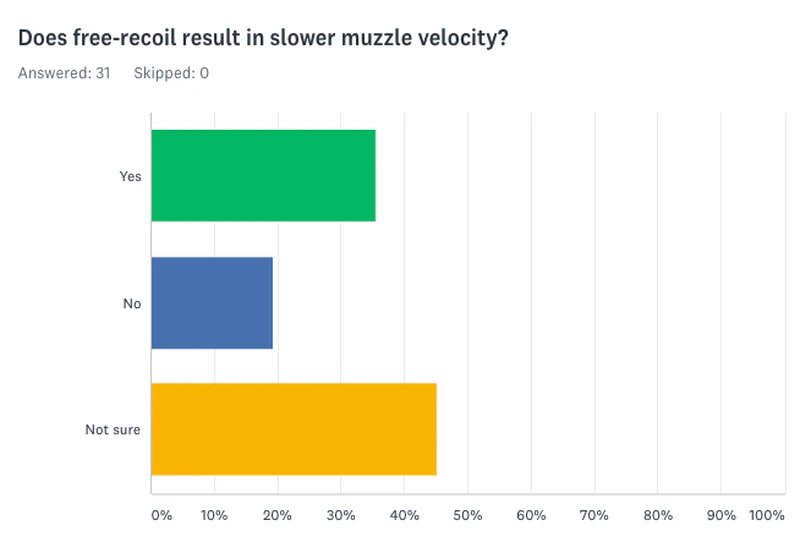
Survey Results: Does free-recoil result in slower muzzle velocity?
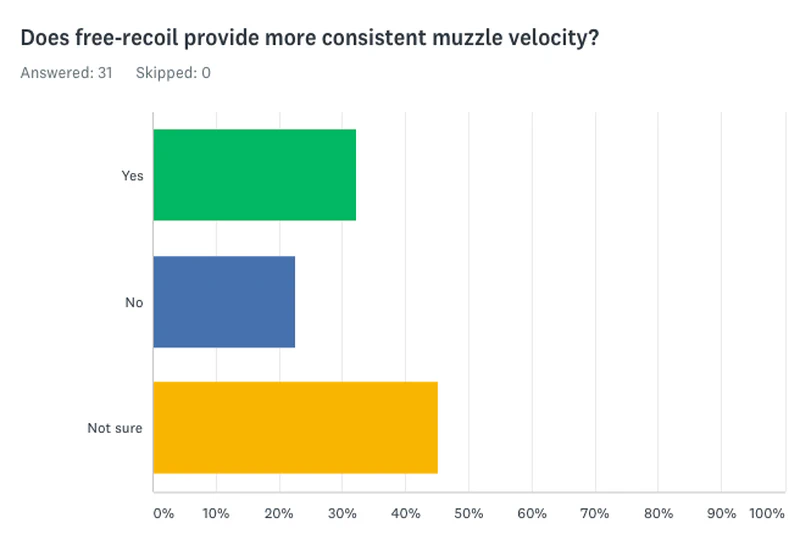
Survey Results: Does free-recoil provide more consistent muzzle velocity?
Admittedly, these may not have been the best survey questions to ask.
Suffice it to say, the results were mixed. There was a lack of solid understanding of this topic which motivated me to continue blazing down this rabbit hole in search of the truth.
My Approach
The first step is to understand what problem we're trying to solve. The question is: Does recoil have any effect on muzzle velocity?
To answer this, we need a better way to determine causality between recoil-management techniques and the velocity of the bullet as it leaves the barrel. More observations would be required in order to measure the other forms of energy that are exhibited by a rifle under recoil. Measuring just speed of the bullet is insufficient – we need more data.
When a round is ignited, the chamber of the firearm experiences enormous levels of pressure. This chamber pressure begins as the propellant is burned, before the bullet breaks away from the brass and moves down the barrel, so I ran on the assumption that it should not be affected by recoil. Using a Pressure Trace II system to record chamber pressure, I was curious to observe and compare the relative muzzle velocities of rounds that exihibited similar pressure levels.
To take it a step further, I also wanted to measure how the firearm itself moved under recoil. To accomplish this, I built a custom accelerometer unit using off-the-shelf components and wrote some software for it. It's an interesting project by itself and you can read more about it in another article.
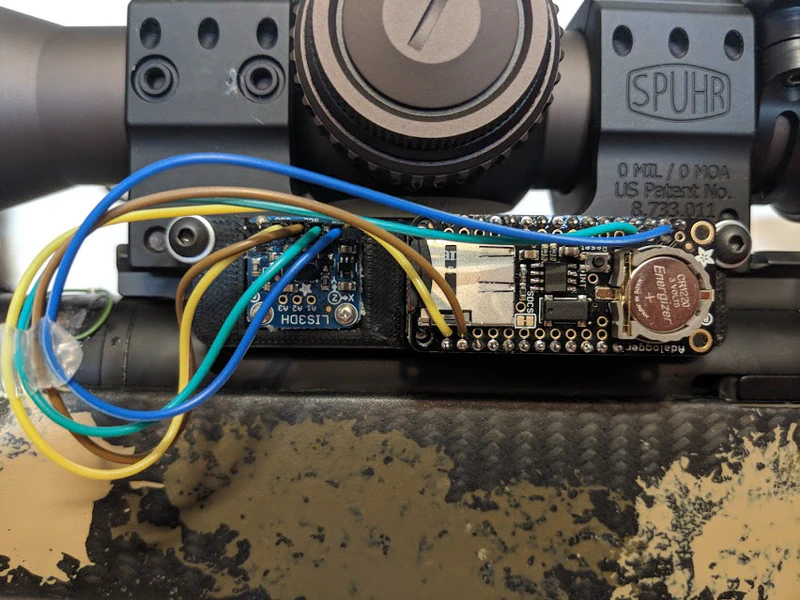
Homebrew 3-Axis accelerometer securely mounted.
With the combined measurements of muzzle velocity, chamber pressure, and acceleration for every round fired, I expected to be able to produce conclusive results.
Conducting the Experiment
To improve the signal-to-noise ratio and increase my chances for success, I wanted to provide extreme differences between my recoil management techniques.
- Preloaded Bipod string: I pressed the bipod tightly against a solid surface (some 2x4s strapped to the bench).
- Free-Recoil string: I used an F-class style front rest to safely fire without mitigating any recoil.
I didn't have access to any kind of machine rest, but that probably would have been better than a preloaded bipod to immobilze the firearm.
In late August, I loaded up 25 rounds and headed to the range with all of my gear. As you can imagine, setting up this much equipment on the firing line generates plenty of weird looks. Everyone was really friendly though and when I explained what I was working on, they were genuinely curious to see the results. As was I.
After setting up the rifle, chronograph, chamber pressure system, turning on the camera, and connecting the battery to the accelerometer, it was finally time to fire some rounds. Since the actual hits on target weren't important for the purposes of the experiment, I fired at steel targets that they keep set up at 300 yards.
Equipment
- Bolt-action rifle chambered in 6.5mm Creedmoor (288.47 oz/8178 g)
- Grizzly F-Class front-rest
- MagnetoSpeed V3 chronograph
- RSI Pressure Trace II
- 3-Axis accelerometer
- Macbook Pro
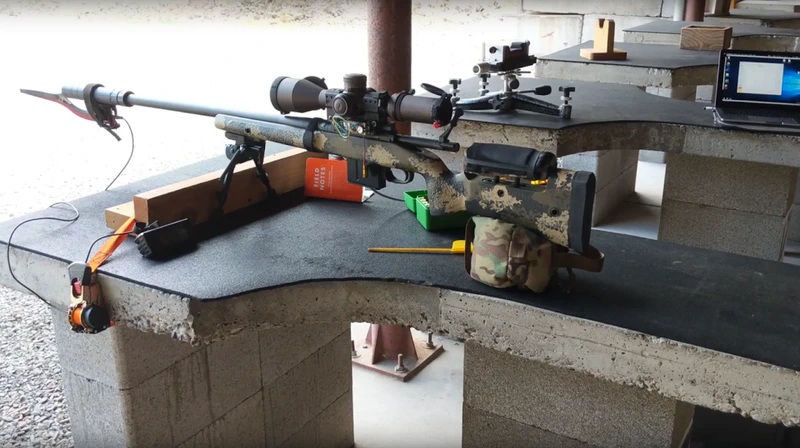
You get a lot of side-eye when you bring this much gear to the range.
Load recipe
- Bullet: 142gr 0.264" 6.5mm Sierra MatchKing
- Powder: 41.6gr Hodgdon H4350
- Brass: Lapua 6.5mm Creedmoor (small rifle primer)
- Primer: CCI BR-4
Note: While I did sort my bullets by length, I measured from the ogive to the bullet base. As some of the data below will show, I believe this may have caused some inconsistencies.
Rounds fired
- 5 rounds for sighters/foulers
- 10 rounds with preloaded bipod
- 10 rounds with free-recoil/front rest
Note: Due to an issue with the chamber pressure system, it did not record the first sighter/fouler shot. I did get a reading from the chronograph and accelerometer, so I had to separate that one shot when analyzing the data.
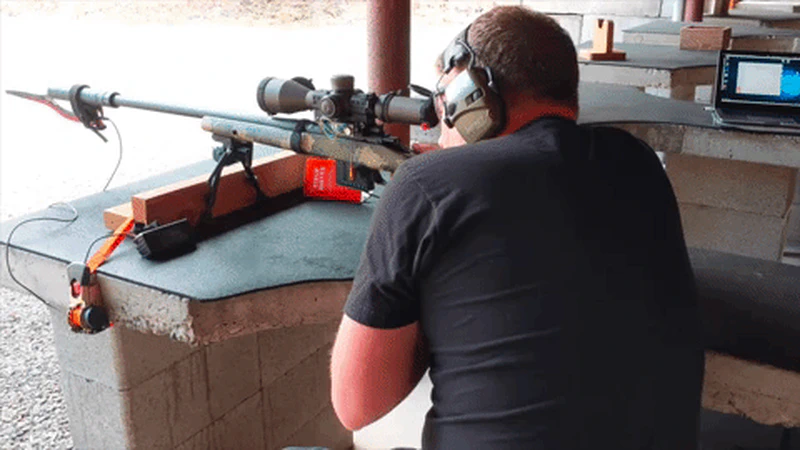
One of 10 rounds fired with a preloaded bipod
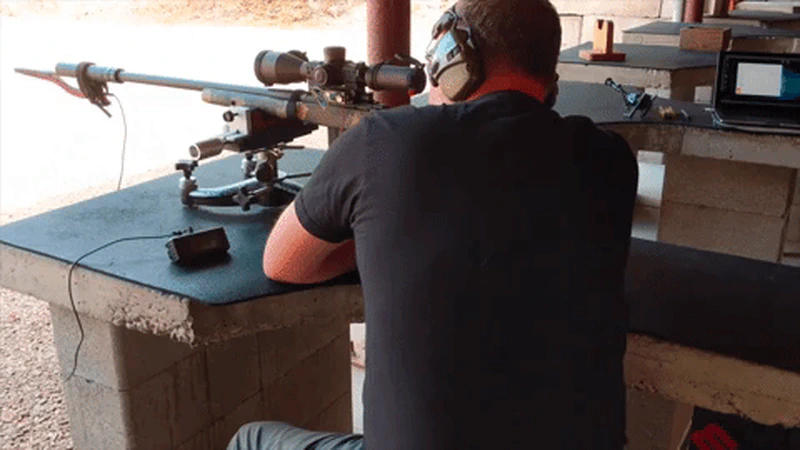
One of 10 rounds fired using the free-recoil technique
Examining the Results
Using three devices to record data created a mountain of data to comb through for answers. I wrote some software and used Python and the Pandas library to make this a bit easier. In the interest of transparency, I've also uploaded the raw data files to GitHub for anyone to explore.
The following tables combine some of the basic information from all three devices for each round fired.
Combined Data: Preloaded Bipod
| Shot | Velocity (ft/s) | Peak Pressure (psi) | Area Under Pressure Curve | Peak Recoil Acceleration (m/s2) | Timestamp |
|---|---|---|---|---|---|
| 1 | 2768 | 40264.05 | 3203834 | 30.65 | 13:10:55 |
| 2 | 2740 | 40504.93 | 3233792 | 31.38 | 13:11:07 |
| 3 | 2774 | 41935.25 | 3269216 | 30.33 | 13:11:18 |
| 4 | 2787 | 42275.57 | 3238018 | 28.83 | 13:11:29 |
| 5 | 2788 | 42292.82 | 3266516 | 30.81 | 13:11:42 |
| 6 | 2776 | 41977.18 | 3171725 | 27.05 | 13:11:52 |
| 7 | 2791 | 43365.56 | 3247774 | 32.66 | 13:12:04 |
| 8 | 2777 | 42292.82 | 3213592 | 26.13 | 13:12:14 |
| 9 | 2781 | 43249.69 | 3345824 | 27.09 | 13:12:24 |
| 10 | 2737 | 39789.78 | 3108994 | 27.01 | 13:12:34 |
Combined Data: Free-Recoil
| Shot | Velocity (ft/s) | Peak Pressure (psi) | Area Under Pressure Curve | Peak Recoil Acceleration (m/s2) | Timestamp |
|---|---|---|---|---|---|
| 1 | 2767 | 41639.90 | 3213611 | 19.62 | 13:24:08 |
| 2 | 2777 | 40876.35 | 3141408 | 18.83 | 13:24:38 |
| 3 | 2778 | 42650.40 | 3192544 | 19.22 | 13:25:27 |
| 4 | 2773 | 41220.09 | 3128323 | 19.89 | 13:25:54 |
| 5 | 2769 | 40862.51 | 3134237 | 19.79 | 13:26:22 |
| 6 | 2778 | 42173.63 | 3214931 | 19.02 | 13:26:46 |
| 7 | 2781 | 41458.48 | 3233612 | 21.94 | 13:27:04 |
| 8 | 2775 | 42292.82 | 3272572 | 18.97 | 13:27:23 |
| 9 | 2780 | 41962.24 | 3187501 | 18.35 | 13:27:46 |
| 10 | 2789 | 42173.63 | 3218879 | 19.08 | 13:28:09 |
Muzzle Velocity
As you can see in the charts below, there were some suprises in the two muzzle velocity data sets but not the surprises I was expecting. Notice that there were two rounds within the Preloaded Bipod group which exhibited significantly slower speeds, with Shot 2 reading 2740 ft/s and Shot 10 at 2737 ft/s.
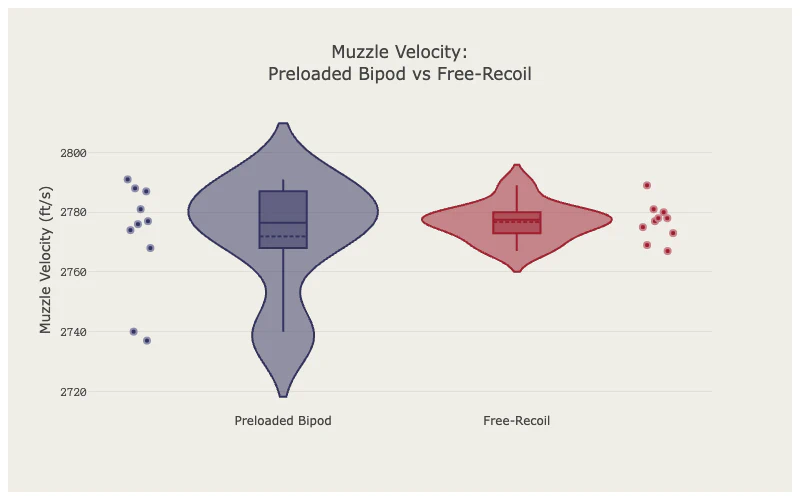 interactive_space Open Interactive Chart
interactive_space Open Interactive Chart
Before jumping to any conclusions about these results, we have plenty more to understand and discuss.
Statistically, the mean (average) of the Free-Recoil group was 4.85 ft/s faster but the median velocity is much closer with only a 1 ft/s difference. I've long advocated for relying on the median velocity instead of the mean, since it's a robust statistic that's affected less by outliers in the dataset like we see here.
So, why were those two rounds slower? Well, I suspect that this issue relates more to my reloading practices (perhaps how I sorted my bullets). We'll come back to that – let's look at the rest of the data to see what else we can learn.
Chamber Pressure
Generally, the recorded chamber pressures for all rounds fired using both techniques were quite similar. There's a bit of variance in the peak pressure readings, as well as peak time, but nothing out of the ordinary.
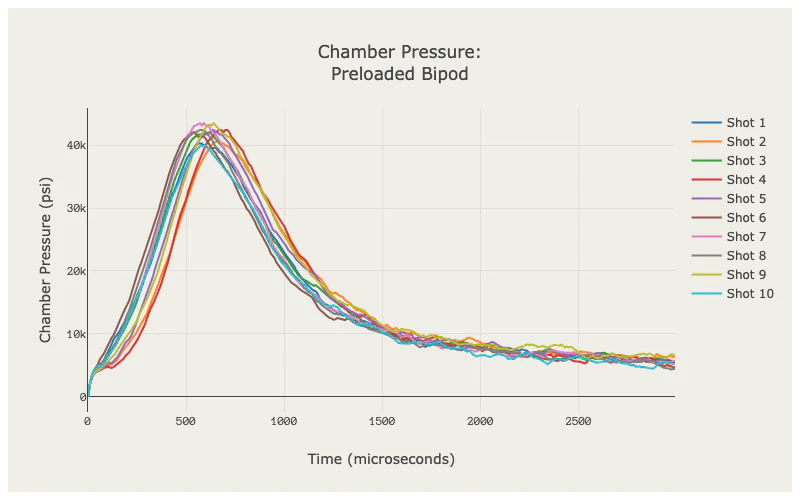 interactive_space Open Interactive Chart
interactive_space Open Interactive Chart
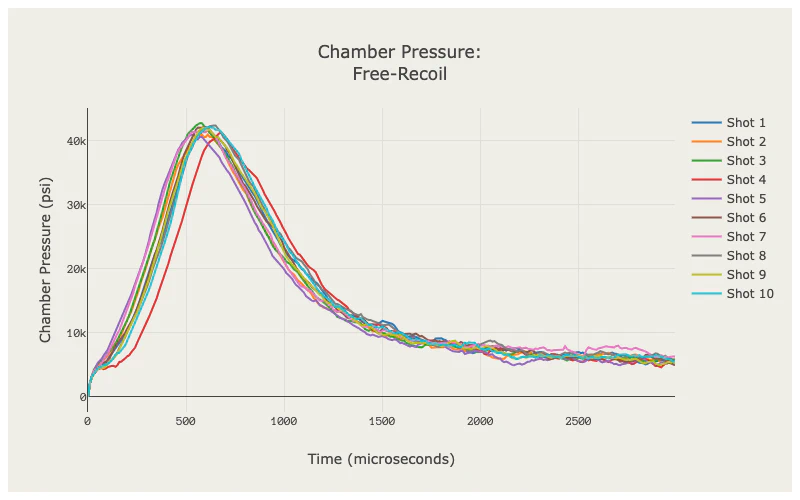 interactive_space Open Interactive Chart
interactive_space Open Interactive Chart
When comparing the peak pressures of both datasets, a more interesting picture emerges.
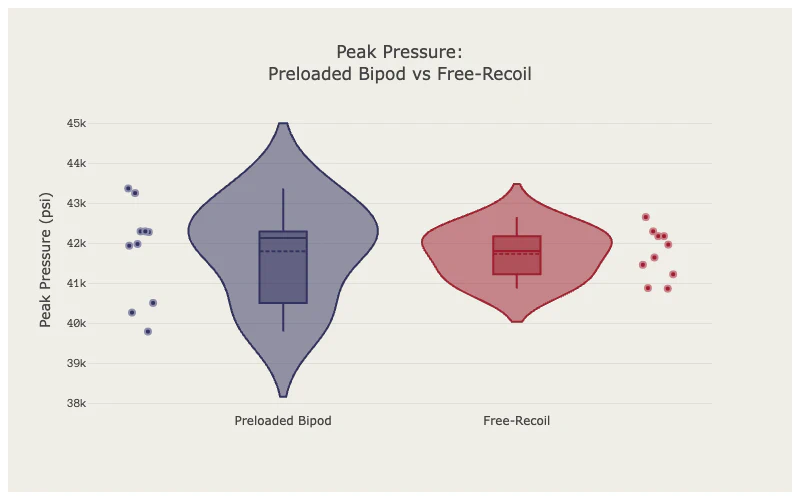 interactive_space Open Interactive Chart
interactive_space Open Interactive Chart
Here's what I noticed:
- There's a greater dispersion on the Preloaded Bipod string than on the Free-Recoil.
- These results are fairly similar to the muzzle velocity comparison.
- Shots #2 and #10 in the Preloaded Bipod string are still outliers, but so is Shot #1.
This agrees with my earlier suspicion, some of which are based on conversations that I had with knowledgable people in the industry about the forces of friction that bullets experience within the rifle. Again, I believe my method for bullet sorting may have caused some problems here because the length of the bearing surface plays a greater role than I understood.
This brings us back to a question I presented earlier. I wanted to compare the pressures exhibited by rounds with a similar or identical muzzle velocity, and vice-versa.
Cherry-Picked Comparisons
Obviously cherry-picking from datasets is not a best-practice and the following are only intended to satisfy curiosity, not inform conclusions.
Matched by Peak Chamber Pressure
| String | Shot | Velocity (ft/s) | Peak Pressure (psi) | Area Under Curve |
|---|---|---|---|---|
| Free-Recoil | Shot 8 | 2775 | 42295.82 | 3272572 |
| Preloaded Bipod | Shot 5 | 2788 | 42295.82 | 3266516 |
| Preloaded Bipod | Shot 8 | 2777 | 42292.82 | 3213592 |
Matched by Muzzle Velocity
| String | Shot | Velocity (ft/s) | Peak Pressure (psi) | Area Under Curve |
|---|---|---|---|---|
| Preloaded Bipod | Shot 8 | 2777 | 42292.82 | 3213592 |
| Free-Recoil | Shot 2 | 2777 | 40876.35 | 3141408 |
| Preloaded Bipod | Shot 9 | 2781 | 43249.69 | 3345824 |
| Free-Recoil | Shot 7 | 2781 | 41458.48 | 3233612 |
What I learned here was that there may not be a direct relationship between peak pressure and muzzle velocity. Maybe. I think there's a good opportunity here for me to continue exploring this topic and if any relationship between various reloading practices can be established.
Recoil Acceleration
The following charts show the acceleration of the rifle under recoil as recorded by the attached sensors. Every curve has been aligned by its peak value in the time series in order to aid the visual comparison.
The device I constructed to record recoil acceleration has some limitations:
- The data below only represents a sample of the actual acceleration.
- Readings were taken as quickly as possible, around every 6 milliseconds, and not at specific regular intervals.
- There are some gaps between readings which are longer than the usual interval.
- The points and curves will not align precisely, because of these irregularities.
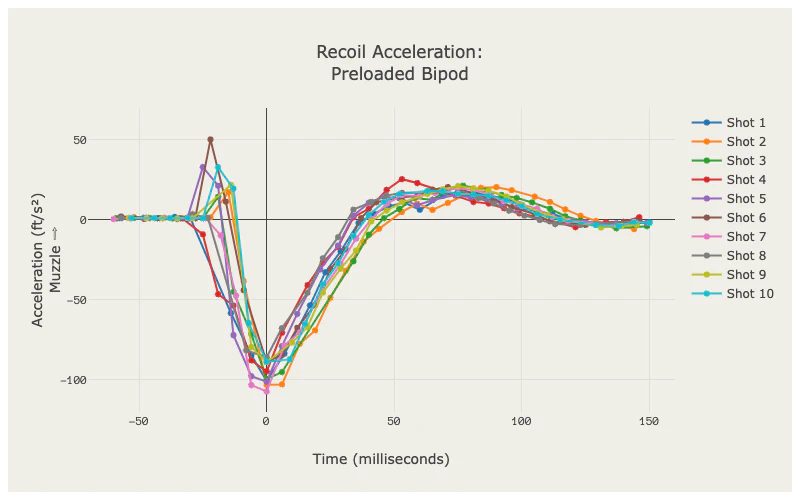 interactive_space Open Interactive Chart
interactive_space Open Interactive Chart
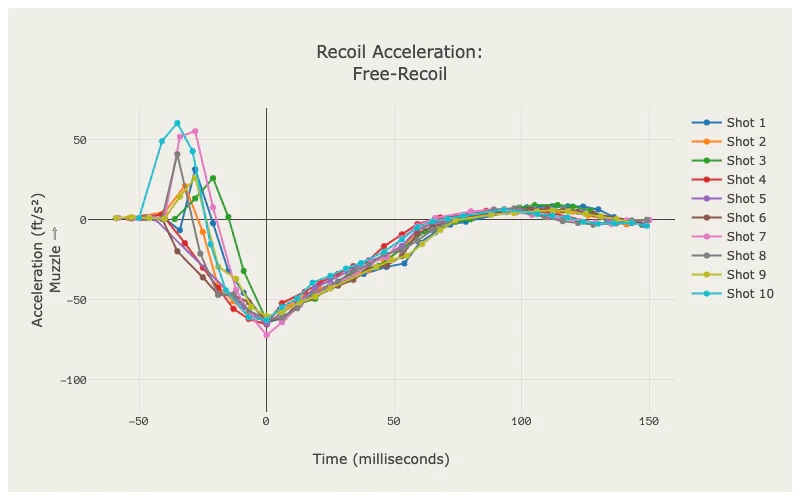 interactive_space Open Interactive Chart
interactive_space Open Interactive Chart
Two things stood out when I first saw these graphs.
- Why was there a small forward acceleration just before recoil?
- Why did the Preloaded Bipod shots have a greater peak acceleration?
I watched the video of each shot frame-by-frame to see if the rifle was moving forward at all before it moved backward under recoil. Nothing. I thought about it for a couple days, wondering if I had done something wrong or if there was a bug in the sensors. What was moving forward? Then it dawned on me – the firing pin! I pulled the rifle out of the safe, turned the accelerometer on, and dry fired a few times to confirm. Sure enough, it was sensitive enough to detect the firing pin and recorded an approximate 32 ft/s² spike in forward acceleration. The first mystery was solved!
Why was there a higher peak acceleration on shots where the rifle moved less? I still don't have a definitive answer to this. My best guess is that energy was not used moving the rifle as far as it did with free-recoil. Comparing the area under the curves, I suspect, would result in nearly equal numbers since the kinetic energy must still be the same. If anybody has an answer to this, please let me know and I'll update this article to include it!
Since the accelerometer was able to record the firing pin and recoil, this creates an interesting view of the problem: time for the rifle to move versus time for the bullet to leave the barrel. You can read more about the technical details of how I extracted this from the accelerometer dataset in another article.
Bullet Acceleration and Barrel Time
Kinematic formulas can be used to calculate the time for the bullet to accelerate in the barrel (length \(x\)) up to the muzzle velocity (\(v\)). The initial velocity (\(v_0\)) is zero and cancels out.
- Total barrel length: 33.125" = 2.760 ft (84.1375 cm = 0.8414 m)
- Suppressor: 9.000" = 0.750 ft (22.8600 cm = 0.2286 m)
- Barrel: 24.125" = 2.010 ft (61.2775 cm = 0.6128 m) Note: I'm being generous, this is measured from the bolt-face.
- Preloaded Bipod
- Median Muzzle Velocity: 2776.5 ft/s (846.2772 m/s)
- Median Recoil Time: 10.429 milliseconds
- Free-Recoil
- Median Muzzle Velocity: 2777.5 ft/s (846.5820 m/s)
- Median Recoil Time: 12.329 milliseconds
Note:
- My accelerometer was only capable of sampling every 6 milliseconds, which might be too coarse for a precise reading.
- I've seen it suggested that there are two stages of recoil, primary and secondary, but I was unable to find a reputable source to verify this.
Preloaded Bipod
- Recoil start time: 10.429 milliseconds
- Bullet barrel time: 1.99 milliseconds
- Delta: 8.430 milliseconds
Free-Recoil
- Recoil start time: 12.329 milliseconds
- Bullet barrel time: 1.99 milliseconds
- Delta: 10.339 milliseconds
The Pressure Trace II software does visually mark barrel time (with the + symbol along the pressure curve), but it does not provide the numbers either on screen or in the data files. Despite this shortcoming of the software, it appears to estimate roughly 1.4 milliseconds of bullet barrel time in both groups (using the barrel length without the suppressor), not too far off from my calculations.
Regardless, these results strongly suggest that the bullet is long gone before the rifle moves under recoil. How long gone? In my case, the bullet was already 23 ft (7 m) down range. This makes sense because the rifle is nearly 900x heavier than the bullet, so it cannot accelerate as quickly.
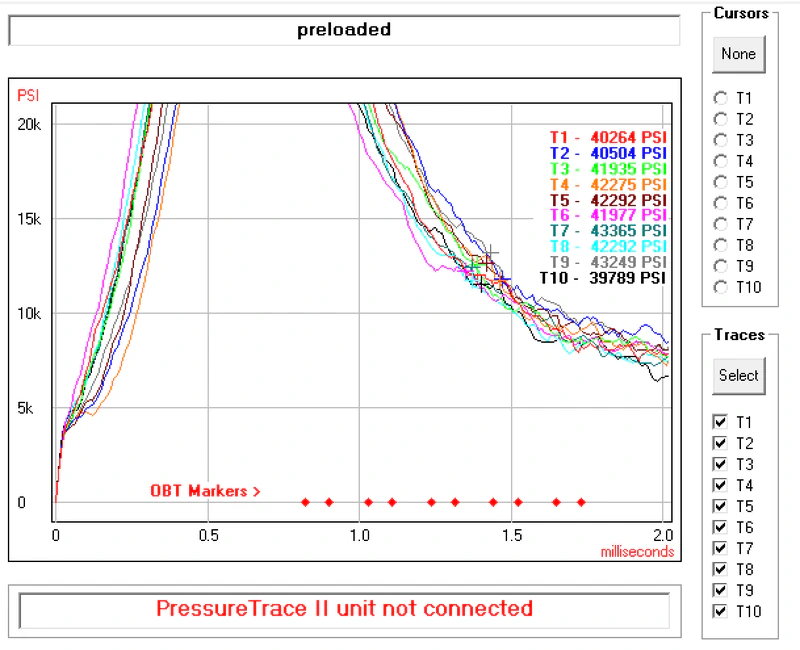
Pressure Trace II screenshot for the Preloaded Bipod string. Barrel exit time marked with +.
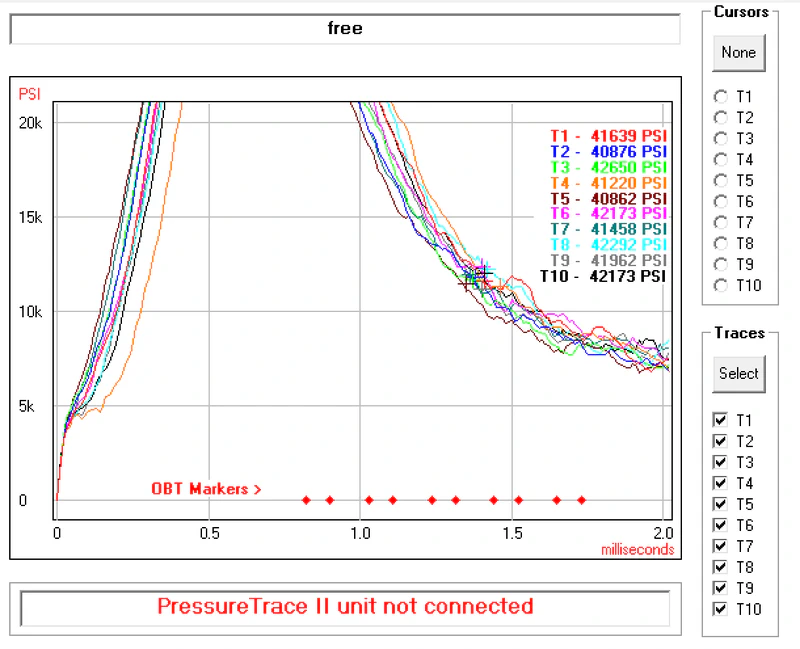
Pressure Trace II screenshot for the Free-Recoil string. Barrel exit time marked with +.
Conclusions
When shooting a precision rifle, preloading your bipod is an incredibly effective technique for managing recoil and getting your sights back on target to watch for impact or prepare for your next shot. However, if you expect it to have an effect on your muzzle velocity, you're going to be disappointed.
Here's what I learned and observed based on the experiment I described above:
- I measured no change in muzzle velocity with either technique.
- Due to huge differences in mass, the bullet has left the barrel before the rifle moves under recoil.
- Chamber pressure readings verified that some of the rounds shot with a preloaded bipod were slower by coincidence, not correlated to or caused by recoil technique.
- The median velocity is more robust than the mean (average) and is better suited for ballistic calculators.
- My reloading practices need improvement, likely around bullet sorting.
Next Steps
- Don't take my word for it I wrote a lot of code for processing the collected data and making it useful. I'm working towards providing this software to everyone so that you can perform these experiments yourself. Shoot me an email if you're interested!
- Have questions or feedback? You can discuss this article with me on Reddit.
- About that accelerometer I've written another article to explain the custom accelerometer in-depth. You can read about it's design, construction, limitations, and how you can build your own for about $50!
- A mathematical approach There are a variety of physics equations for calculating momentum and free recoil energy which I did not include (this article was long enough). I'll explore those in another article in case anyone finds them useful.
- Get a bearing on bullet length Since I'd like to understand it better, a future experiment will focus on the effects of bullet bearing length. I'll post on Instagram, Reddit, and Twitter when I publish those results.
- Contribute Ammolytics is a community-supported project to keep it free of ads and paid-promotions. Making purchases using the affiliate links on this site helps to fund future projects and experiments. You can also support Ammolytics on Patreon!
Special thanks
- My friend Andy, for reviewing this article and giving me some excellent feedback. (He's writing a new Unix shell called Oil!)
- Jim Ristow, from Recreational Software, Inc., for taking the time to answer a mountain of questions about the Pressure Trace II.
- Frank "Lowlight" Galli, from SnipersHide.com, for creating the original material, inspiring this article, and creating a learning opportunity.
Before you go…
Thanks for taking the time to read this article! I enjoyed writing it and learned a lot in this process and I hope that you did too. If you have any feedback, you can email me directly if you don't prefer to use Reddit or other social media.
